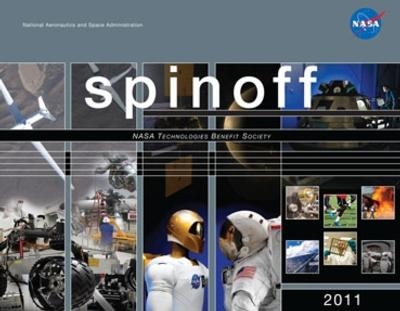Fri, Feb 10, 2012
Latest Edition Follows 44 Technologies From Space To
Terrestrial Pursuits
NASA's Spinoff 2011 publication, now available online, reveals
how the space agency's ingenuity and partnerships have saved
thousands of lives, and generated billions of dollars. The latest
edition of Spinoff records 44 journeys of NASA's most innovative
technologies. It chronicles their origins in NASA missions and
programs and their transfer to the public in the form of practical
commercial products and benefits to society.

"This year's Spinoff demonstrates once again how through
productive and innovative partnerships, NASA's aerospace research
brings real returns to the American people in the form of tangible
products, services and new jobs," NASA Administrator Charles Bolden
said. "For 35 years, Spinoff has been the definitive resource for
those who want to learn how space exploration benefits life on
Earth."
NASA spinoffs have proven benefits in health and medicine,
transportation, public safety, consumer goods, energy and the
environment, information technology, and industrial productivity,
stimulating the economy and creating new jobs and businesses.
Among the technologies highlighted in the edition:
- A new firefighting system, influenced by a NASA-derived rocket
design that extinguishes fires more quickly than traditional
systems, saving lives and property.
- Software employing NASA-invented tools to help commercial
airlines fly shorter routes and help save millions of gallons of
fuel each year, reducing costs to airlines while benefiting the
environment.
- A fitness monitoring technology developed with the help of NASA
expertise that, when fitted in a strap or shirt, can be used to
measure and record vital signs. The technology is now in use to
monitor the health of professional athletes and members of the
armed services.
- An emergency response software tool that can capture, analyze
and combine data into maps, charts and other information essential
to disaster managers responding to events such as wildfires, floods
or earthquakes. This technology can save millions of dollars in
losses from disasters and, more importantly, can help save lives
when tragedy strikes.
- This year's Spinoff includes a special section to celebrate the
commercial technologies that resulted from NASA's 30-year Space
Shuttle Program. Also featured are spinoffs that have come from the
construction of the International Space Station and work aboard the
orbiting outpost. An additional section discusses the potential
benefits of NASA's future technology investments.
"NASA's Office of the Chief Technologist has more than a
thousand projects underway that will create new knowledge and
capabilities, enabling NASA's future missions," NASA Chief
Technologist Mason Peck said. "As these investments mature, we can
expect new, exciting spinoff technologies transferring from NASA to
the marketplace, providing real returns on our investments in
innovation."
More News
“...no entity, whether a division of government or a private company or corporation, may use information broadcast or collected by automatic dependent surveillance-broadcast >[...]
Growth And Fleet Replacements On The Way International Airlines Group, a joint holding company between British and Spanish air carriers, announced it has ordered up to 76 new Boein>[...]
Expert Analysts Scrutinized the FAA’s Oversight of ATC Organization In a move that appears somewhat mistimed (at best…tone-deaf at worst), the Federal Aviation Adminis>[...]
Community Continues to Push Back Against ADS-B-Facilitated Landing Fees On May 8, a bill to limit frivolous use of ADS-B tracking data was signed into law by Montana Governor Greg >[...]
Duffy Shares Plans to Scale Back Flights at Newark Liberty International After a ‘telecommunications issue’ with Philadelphia TRACON brought yet another string of delay>[...]
 Aero-News: Quote of the Day (05.13.25)
Aero-News: Quote of the Day (05.13.25) IAG Orders 76 Boeing, Airbus Airliners
IAG Orders 76 Boeing, Airbus Airliners FAA Shuts Down ATC Oversight Review Amid Scrutiny
FAA Shuts Down ATC Oversight Review Amid Scrutiny Montanas ADS-B Privacy Bill Signed Into Law
Montanas ADS-B Privacy Bill Signed Into Law Newark Falls Victim to More Equipment Outages
Newark Falls Victim to More Equipment Outages



